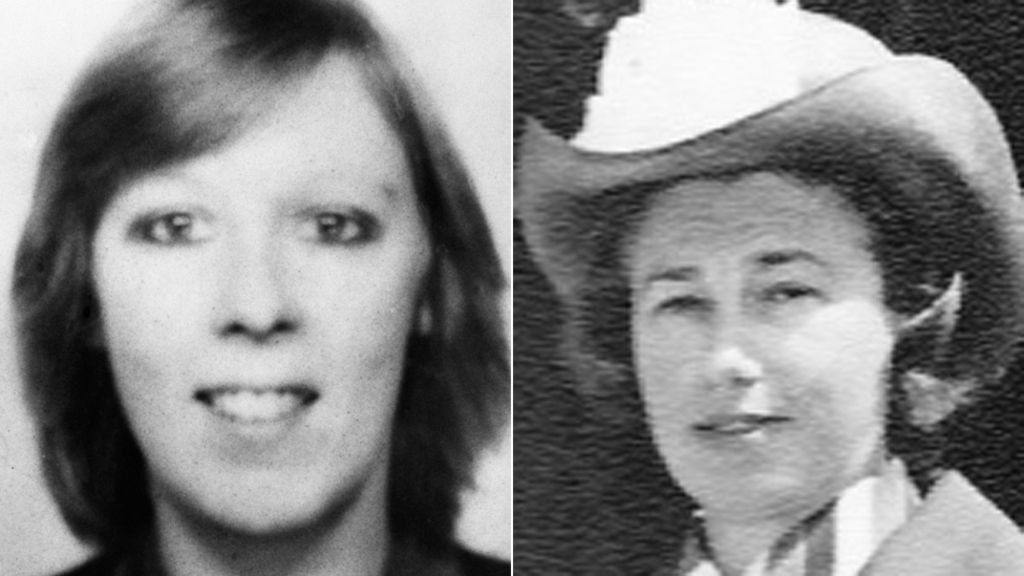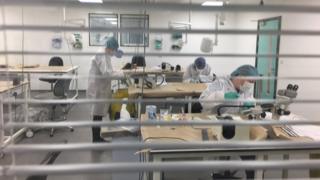Cold cases: The detectives on the trail of undiscovered killers – BBC News


A dedicated team of British detectives is working to solve cold case murders. And with advances in forensic science, they are hoping to bring some of the killers to justice.
At midday, on 24 November 1975, Margaret Lightfoot left her home in Loughton to take her Airedale puppy for a walk in nearby Epping Forest.
Mrs Lightfoot was seen by a neighbour.
Later, another neighbour saw the dog running loose in the street and took it back to Mrs Lightfoot’s house, leaving it in the garden.
When Mrs Lightfoot did not return home, her husband reported her missing in the early evening and a search was started.
It was called off after dark and resumed the next morning, when Margaret’s naked body was found in heavy undergrowth. She’d been strangled.
 Image copyright Sue Lightfoot
Image copyright Sue Lightfoot “It was a huge shock,” says Mrs Lightfoot’s daughter, Sue, who’s never spoken publicly about the murder before. Her mother was the “hub” of the family, she says, a “wonderful, loving person” with a huge circle of friends.
“For my father, it obviously turned his life upside down – he lost his lifetime soulmate and companion,” says Sue.
“For my sister and me – we never had the opportunity to share and enjoy our children with her.”
Despite an extensive investigation, during which more than 100 potential suspects were interviewed, police were unable to identify Mrs Lightfoot’s killer.
However, a detailed type-written report of the case from the officer in charge at the time has been recovered from police archives, together with items of evidence known as “exhibits”.
And they’ve given police renewed hope of a breakthrough.
Wellington boots
“We have been lucky, because we still have some property from the crime scene,” says acting Detective Inspector Susan Stansfield, an officer from the Metropolitan Police’s cold case unit.
“We’ve asked our forensic scientists to re-examine those items to see if we can use any modern-day techniques – back then we would only have been able to fingerprint items,” says DI Stansfield.
She is part of small unit of detectives based at a south London police station who regularly review unsolved cases to see if there is any work to be done.
The “new techniques” are DNA-based and some of them can be used to retrieve samples in a way that was not possible before.
Contact or touch DNA can now be extracted from skin cells left behind when someone comes into contact with an object.
In the Margaret Lightfoot case, officers began looking at the case again after her widower – now aged 90 – saw something on TV and rang the police.
Scientists are focusing on the two Wellington boots Mrs Lightfoot had been wearing, found underneath her body.
Detectives believe the boots had been pulled off by her killer and may therefore contain traces of his DNA.
But DI Stansfield says there’s a hurdle to overcome first. The way the boots were fingerprinted in 1975 may have compromised later tests.
“The methods that were used can sometimes be very destructive of DNA processes now, so we have really got our fingers crossed,” she says.
 Image copyright PA
Image copyright PA In some cold cases, DNA profiles can’t be obtained because the science isn’t advanced enough.
Sally Shepherd was 24 years old and the restaurant manager at the Young Vic theatre when she was murdered in December 1979.
She was brutally attacked and sexually assaulted as she walked home late at night after getting off a bus in Peckham, south London.
Her body was discovered in a builder’s yard behind a police station.
Some 44 suspects were identified and eliminated from the original inquiry – among them the Yorkshire Ripper, Peter Sutcliffe.
However, police have now revealed they have a potentially vital clue – three strands of hair, which could well be from the killer.
The difficulty is the hairs are rootless.
Perfected
Hairs without roots can be used to determine ethnicity, helping narrow down a field of suspects or confirm the identity of someone already in the frame.
But unlike hairs with a root, rootless hairs will not deliver a full DNA profile, in most cases.
“At the moment, that nuclear DNA that we normally find in the hair root is so degraded and so poor quality on a hair shaft that there is no way that we can normally get a result,” says David Ballard, an expert in DNA analysis at King’s College, London.
Without the guarantee of results, scientists are “very cautious” about examining hairs because there’s a danger they’ll use up the sample as it undergoes testing.
“Eventually you will run out of the evidence and this is something we do see in cases,” says Dr Ballard.
It’s certainly not a risk DI Stansfield is prepared to take, with only three strands of hair from the scene of Miss Shepherd’s murder.
“They remain locked away until science is very much perfected on extracting the DNA from those,” she says. “I can’t sacrifice those.”
She may have to wait three or four years, by which time scientists believe there’ll be other key developments.

For example, work is going on to identify physical characteristics of someone from a spot of blood.
“We can definitely very easily do things like ethnicity and within the next few years we are seeing more and more features that are being investigated,” says Dr Ballard.
“Can you tell whether someone is likely to be bald? Yes you can to a good extent.
“Can you tell if they are likely to have curly or straight hair? There is a lot of work on that at the moment, physical features of the face,” he says.
But there is a catch.
Key in door
The key to cracking a cold case lies in preserving evidence – and in some cases it is simply not there.
“The biggest challenge is information and the lack of [it],” says Joe Marchesi, an operational forensic consultant for Scotland Yard.
“You are always optimistic but there is the reality that often the material doesn’t exist.”
DI Stansfield says she has gone as far as she can with one case she was desperate to solve – the murder in November 1985 of Clara Kirton.
She was last seen alive at 10:00 on Saturday 16 November, a few days before her 86th birthday.
A friendly woman who was surrounded by family and friends in the area, it was known locally that she left the key in her door so visitors could let themselves in.

She was attacked in her flat in Southwark, south London, with a broken beer bottle.
Mrs Kirton was found on the Sunday by her son. Police suspect it was a burglary gone wrong.
“With that one we haven’t got any exhibits,” DI Stansfield says.
“We’ve looked at it, gone over it, spoken with the family and unfortunately at this stage we can’t go any further.”
In the case of Margaret Lightfoot, though, police are still actively investigating, hoping that scientific tests will lead them to the killer.
Solving the crime would mean a huge amount to Margaret Lightfoot’s widower.
As for their daughter, Sue, she believes it could prevent other people falling victim as her mother did.
“The main thing for me is that it must just never happen again, and if this particular person has the potential and the ability to cause such huge pain and such a brutal death to somebody then, yes, he absolutely needs to be caught.”
Read more: http://www.bbc.co.uk/news/uk-38347852